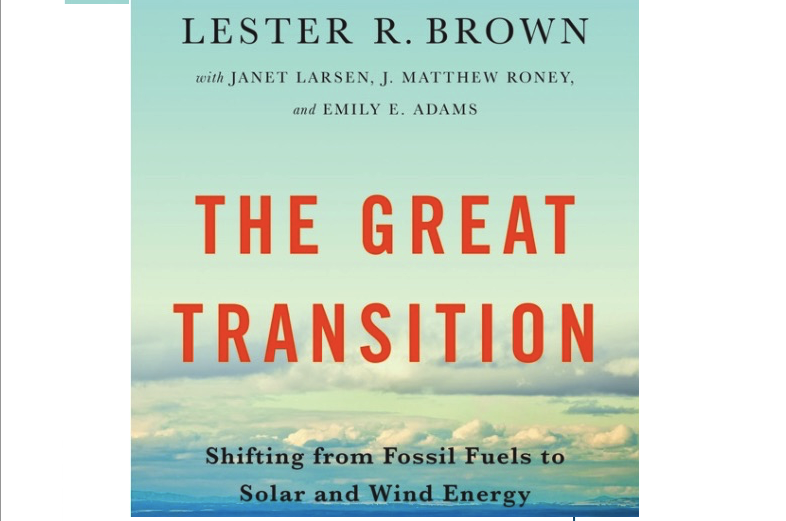. . SUSTAINABLE DEVELOPMENT . .
An article by the Earth Policy Institute (abridged)
The global transition to clean, renewable energy and away from nuclear and fossils is well under way, with remarkable developments happening every day. The Great Transition by Lester Brown, Janet Larsen, Matt Roney, and Emily Adams lays out a tremendous range of these developments – here are seven that may surprise you.

1. Solar is now so cheap that global adoption appears unstoppable.
• The price of solar photovoltaic panels has declined 99 percent over the last four decades, from $74 a watt in 1972 to less than 70 cents a watt in 2014.
• Between 2009 and 2014, solar panel prices dropped by three fourths, helping global PV installations grow 50 percent per year. . .
2. Wind power adoption is rapidly altering energy portfolios around the world.
• Over the past decade, world wind power capacity grew more than 20 percent a year, its increase driven by its many attractive features, by public policies supporting its expansion, and by falling costs.
• By the end of 2014, global wind generating capacity totaled 369,000 megawatts, enough to power more than 90 million U.S. homes. Wind currently has a big lead on solar PV, which has enough worldwide capacity to power roughly 30 million U.S. homes. . .
3. National and subnational energy policies are promoting renewables, and many geographies are considering a price on carbon.
• Unfortunately, governments worldwide still subsidized the fossil fuel industry with over $600 billion, giving this aging industry five times the subsidy that went to renewables.
• But by the start of 2014, some 70 countries, including many in Europe, were using feed-in tariffs to encourage investment in renewables. . .
4. The financial sector is embracing renewables – and starting to turn against fossils and nuclear.
• The financial services firm Barclays downgraded the entire U.S. electricity sector in 2014, in part because in its view U.S. utilities are generally unprepared for the challenges posed by distributed solar power and battery storage.
• In January 2013, Warren Buffett gave solar energy a huge financial boost when his MidAmerican Energy Holdings Company announced an investment of up to $2.5 billion in California in what is now known as the Solar Star project. At 580 megawatts, it will become the world’s largest PV project when complete in late 2015. MidAmerican had earlier bought the Topaz solar farm in California, now tied with Desert Sunlight, another California project, as the world’s largest at 550 megawatts. As of its completion in late 2014, Topaz can generate enough electricity to power 180,000 California homes. . .
5. Coal use is in decline in the United States and will likely fall at the global level far sooner than once thought possible.
• U.S. coal use is dropping – it fell 21 percent between 2007 and 2014 – and more than one-third of the nation’s coal plants have already closed or announced plans for future closure in the last five years.
• Major U.S. coal producers, such as Peabody Energy and Arch Coal, have seen their market values drop by 61 and 94 percent, respectively, as of September 2014. . .
(Article continued on right side of page)
What is the relation between the environment and peace?
Are we making progress in renewable energy?
(This article is continued from the left side of the page)
6. Transportation will move away from oil as electric vehicle fleets expand rapidly and bike- and car-sharing spreads.
• Bike-sharing programs have sprung up worldwide in recent years. More than 800 cities in 56 countries now have fully operational bike-share programs, with over 1 million bikes. In the United States, by the end of 2012 some 21 cities had 8,500 bikes in bike-share racks. By the end of 2016, this is expected to climb to over 70 cities with close to 40,000 bikes.
• The share of carless households increased in 84 out of 100 U.S. urban areas surveyed between 2006 and 2011. And as urbanization increases, this share will only rise. . .
7. Nuclear is on the rocks thanks to rising costs and widespread safety concerns.
• For the world as a whole, nuclear power generation peaked in 2006, and dropped by nearly 14 percent by 2014.
• In the United States, the country with the most reactors, nuclear generation peaked in 2010 and is now also on the decline. . .
Chapter 1 of The Great Transition: Shifting from Fossil Fuels to Solar and Wind Energy is available online at www.earth-policy.org/books/tgt. Supporting data and a PowerPoint summary presentation are also available for free downloading.
(Thank you to Janet Hudgins, the CPNN reporter for this article.)